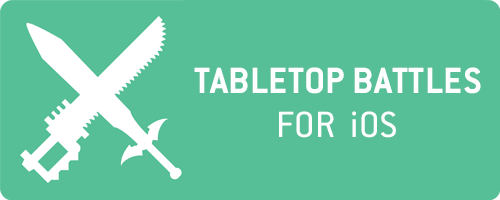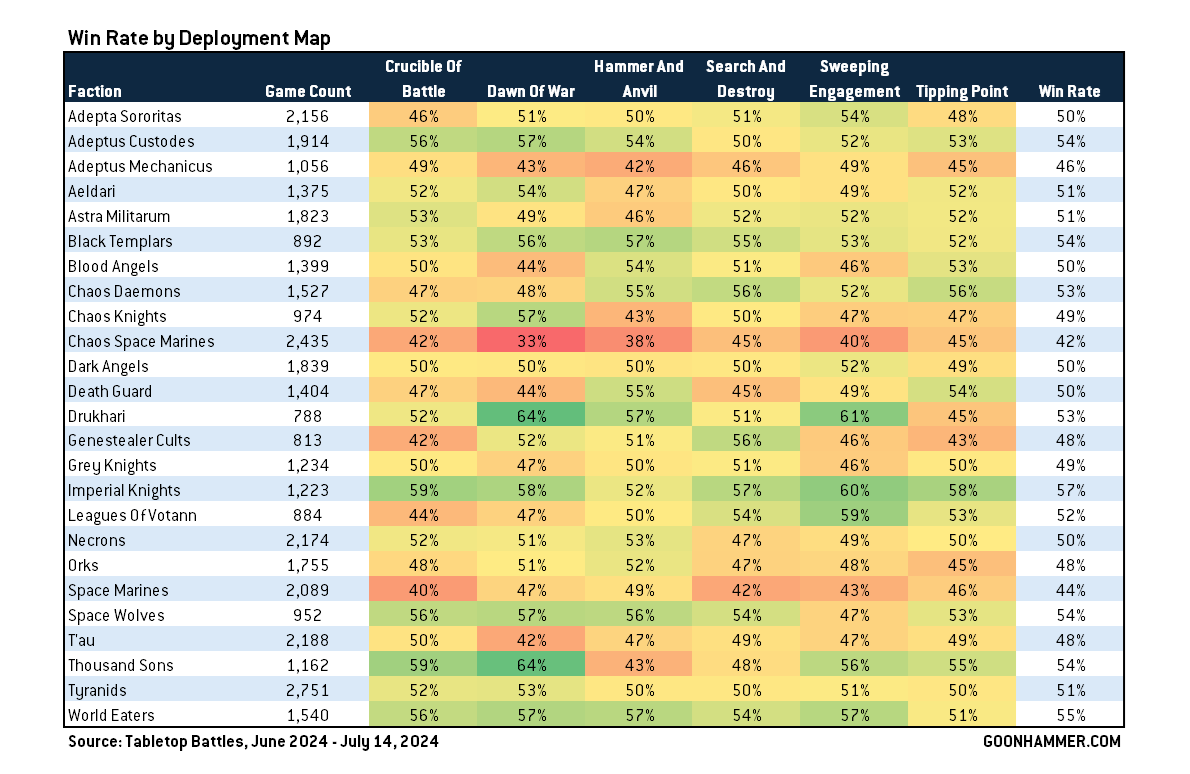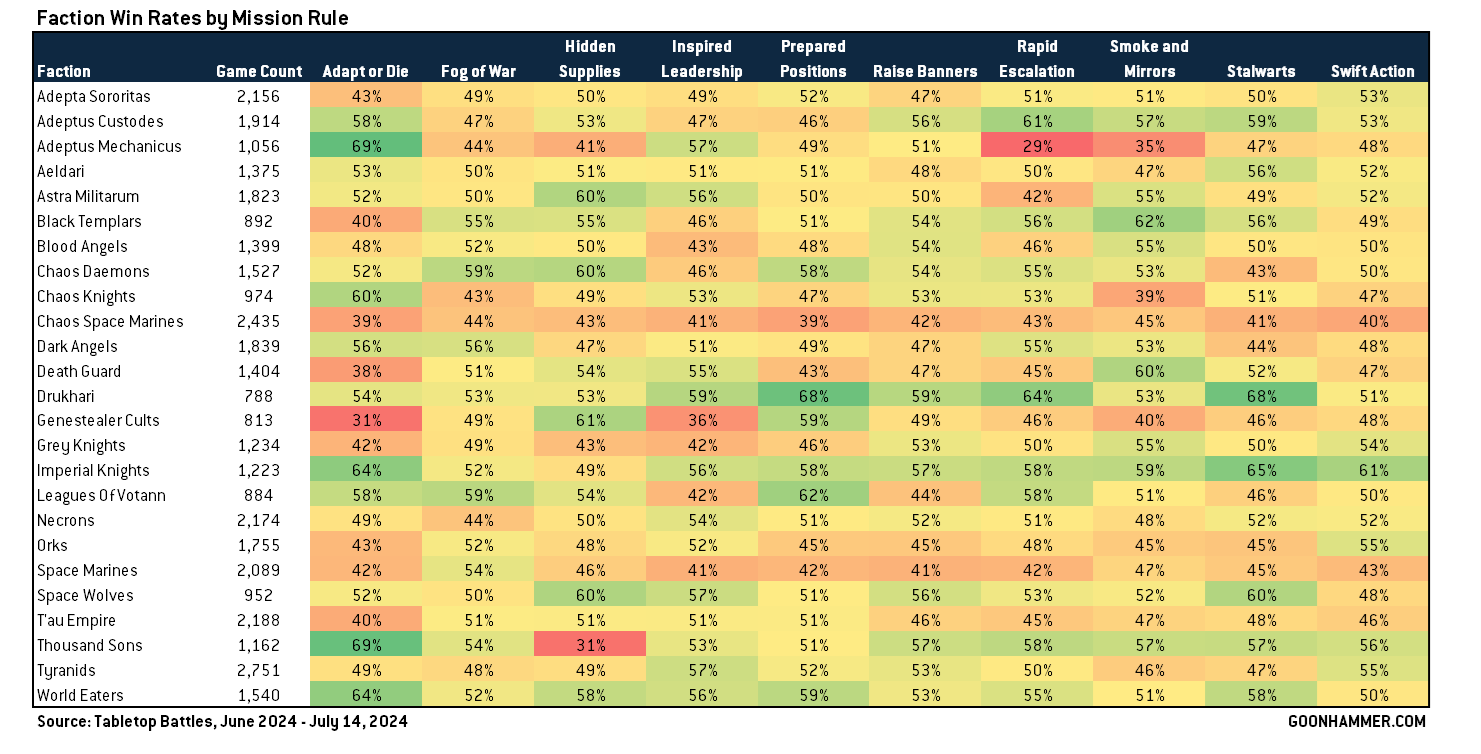In Hammer of Math we look at statistics and probability in Warhammer. This week, we’re looking at data collected from games logged using the Tabletop Battles App.
Welcome back to Hammer of Math and our look at stats from the Pariah Nexus missions collected in the Tabletop Battles App. We last looked at these games two weeks ago – you can find that article here – and the first ten thousand or so games collected in the app. We took a week off to run the 2024 US Goonhammer Open but this week we’re back as promised with a look at the stats we didn’t see last week.
Methodology
Before we dive in to the stats, it’s worth talking about where this data comes from – the data in this article comes from Goonhammer’s Tabletop Battles App, and specifically completed games logged with the Pariah Nexus GT Missions. We’ve revisited our initial data this week, paring down the data by removing a number of games with unfinished results and adjusting our date ranges – specifically we’re looking at games logged since June 28th, as we had to correct an issue with Secret Missions that week which affected how players could use them, so we’re tossing out the games before that change.
If you haven’t already, go download the app. It is hands-down the best app out there for tracking games of Warhammer 40k, and with support for 10th edition and the Pariah Nexus missions pack there is no better way to track your scores and secondary objectives. It even has correct terrain deployment maps which correct the typos in the packet published by Games Workshop.
Note: If you already have an Administratum account, that login will also be your Tabletop Battles login – just use the same account you’ve already made. If you are creating a new account, you can use that account for Administratum later!
Revisiting Faction Win Rates
Let’s go back to our faction win rates from last week. We have more games now and a ton more stability, and it’s worth revisiting win rates for each faction now that we’ve had another two weeks of Pariah Nexus games to really help even things out.
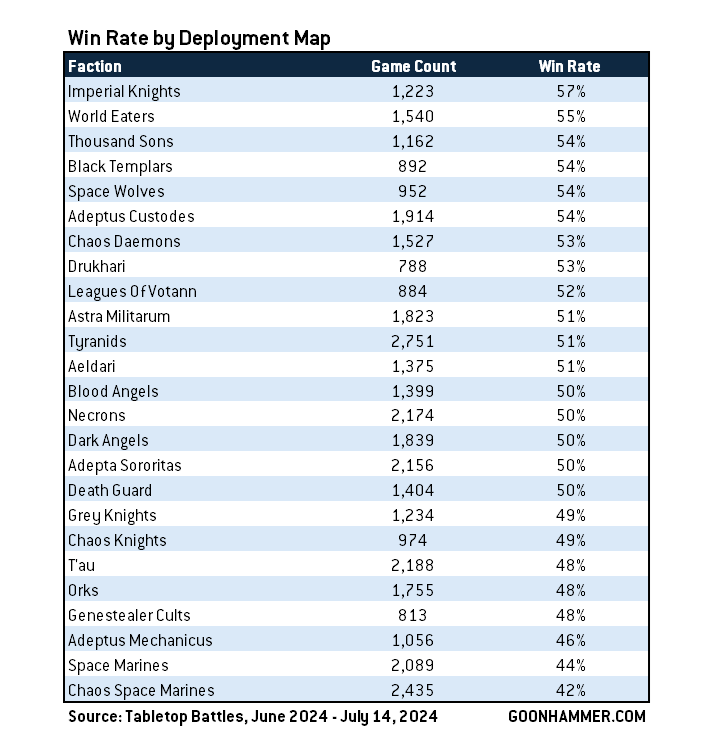
With more games, our win rates look a lot less volatile and a lot more healthy – our band now runs from 42% (Chaos Space Marines) to 57% (Imperial Knights), and while that’s a little wider than we’d like, only three factions fall outside of that “Goldilocks band” of 45-55% win rates. If we cross-reference this with the latest results over on Stat-Check, we see pretty similar results, though there are some key differences – in part because the tournament games sample size is just much smaller (their sample has 159 Drukhari games, for example), and they’re looking at a very specific player base, giving a more specific look at the meta.
Deployment Map
Let’s dive into the first of four areas we’re going to look at results today: Deployment Map. There are six deployment maps in Pariah Nexus, and three of them put armies pretty close together, though the Pariah Nexus Tournament Companion missions tend to be biased away from some of those options (specifically, Sweeping Engagement and Dawn of War). Here’s how our faction
There’s a lot there and it’s hard to spot real trends – it’s also worth noting that while all of these cuts generally have more than one hundred games behind them, they’re much smaller and more volatile than we’d usually see. I have no idea why Chaos Space Marines just seem to eat shit on Dawn of War, but melee-focused armies like Daemons, Black Templars, World Eaters, and Space Wolves seem to really like Search and Destroy and Sweeping Engagement, and Imperial Knights and Votann seem to do well on those as well.
On the other side of things Drukhari really like Sweeping Engagement and Dawn of War, possibly because they’re absolutely capable of making things happen however they please from those new shorter distances.
Primary Mission
Next up let’s look at primary missions. There are nine Primary Missions to choose from in Pariah Nexus, and for these we’re mostly interested in looking at broad scoring and whether any missions are more likely to create blowouts or a first-turn advantage.

Only one primary mission could potentially confer an advantage for going second, and as you might expect, that mission is Purge the Foe – and with the adjustments in the tournament companion (you no longer score Kill More in the first battle round), that advantage is negligible if it exists at all (it also may be offset by other factors, as we’ll see in a moment). The missions which appear to advantage a player going first the most are Unexploded Ordnance, Take and Hold, and Terraform. Terraform and Unexploded Ordnance both have solid rewards for going first – being able to terraform objective markers and deny them to an opponent and moving objective markers, respectively, which make going first a big deal on these missions.
Take and Hold is more interesting as it seems very straightforward. However it’s worth noting that it’s one of three missions which allow you to score for holding the objective in your deployment zone. The other two here are Linchpin, in which you score more for holding No Man’s Land objectives if you control your home objective, and Purge the Foe, which strongly advantages the player going second with its “kill more” condition. There are, as always, confounding factors. But it’s worth considering that Take and Hold, which allows players to play much more conservatively going first early may give a larger advantage to the player going first. Digging deeper, this advantage is even larger for Take and Hold missions with the Search and Destroy (+2.6) and Hammer and Anvil (+2.5) deployment maps.
On the other axis we were looking at, Supply Drop creates the biggest blowouts with an average point differential of 16.8 and that’s no surprise, either – that mission often feels like it comes down to whoever happens to be closer to the final objective.
Mission Rule
Next up let’s look at the mission rule. There are a lot of these to consider – ten in total – and as with Deployment Map I’m going to sidestep some of the harder questions by just dumping the data here and then talking trends afterward. As with deployment map, these totals are a bit smaller and so more volatile, and some of these faction/mission rule combinations absolutely have fewer than one hundred games.
Another chart with too much data! We’ll eventually revisit some of this more closely when we have more data but for now it’s fun to look at and speculate on what trends we may see emerging. For example, it looks like Drukhari, Thousand Sons, Space Wolves, Imperial Knights, Custodes, and World Eaters really like Stalwarts. Not sure why World Eaters do well there but it makes sense for Thousand Sons and Custodes, who really want to be able to shoot with their limited units while capturing objectives. Chaos Daemons really like Hidden Supplies, where they can create Shadow of Chaos more easily by holding 2/4 objectives instead of 2/3. Custodes and Drukhari really like being able to bring in reserves turn 1 using Rapid Escalation.
One trend that does seem to be visible: Melee armies really don’t seem to like Swift Action, where they will have a harder time stopping enemy units from performing actions when Battleline units can just Fall back and perform an action.
Secondary Missions
There are 18 Secondary Missions in the Pariah Nexus deck, and of these eight can be selected as Fixed options (Recover Assets was removed as an option in the Tournament Companion. Players score an average of 22.7 VP on secondary per game and choose Fixed Secondary missions around 12% of the time in Pariah Nexus.
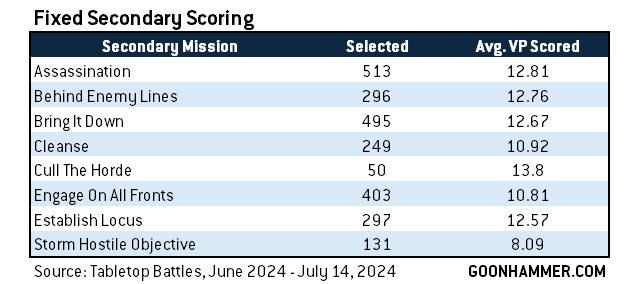
While Cull the Horde has the highest payoff of any fixed secondary, it’s also the least-selected by a wide margin, and that’s no surprise given it has the narrowest application.
As we predicted, Bring it Down saw a huge hit in scoring thanks to the changes, and now averages only 12.7 VP when selected for fixed, down from 14.2 in Leviathan. Assassination remains as effective as before, averaging 12.8 VP (compared to 12.3 before), while Establish Locus is a predictable 2 VP worse on average than Deploy Teleport Homers was. The big surprise here is Engage on All Fronts, which was the third most selected fixed secondary objective, and in its new form players taking it averaged 10.8 VP, an improvement of 1.5 VP on average over Leviathan.
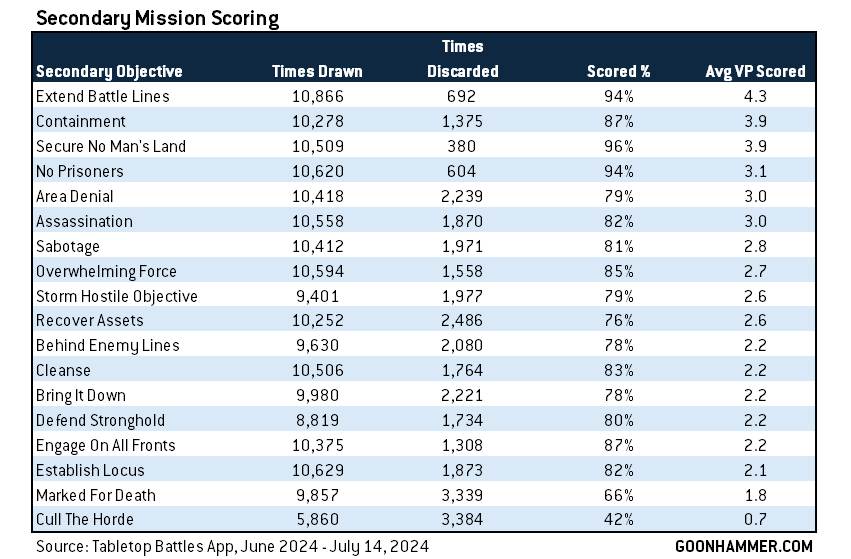
There’s a lot of data here but unlike the prior charts, we can make some real sense out of this one. First off, note that “Times Drawn” column – that really should read “times retained,” as it does not include times when someone drew a secondary objective and then immediately discarded it because it was unscoreable. Likewise, “Times Discarded” means “discarded at the end of a player’s turn for CP.”
Extend Battle Lines remains the most free objective in the game, being both easy to score and worth 5 VP if you control your home objective and one in No Man’s Land. Secure No Man’s Land and No Prisoners provide similar returns and together make up the only Secondary Missions with completion rates above 90%.
At the bottom of the list is Cull the Horde – unscorable in most games and discarded, and extremely hard to score otherwise, and my new vote for “Worst Secondary Mission in the game,” Marked for Death, which is scored only 66% of the time, the second-lowest of any secondary mission by a considerable margin.
Secret Missions
Finally, let’s look at Secret Missions. Our adjusted sample of secret missions games contains 7,598 games, and in these, 1,124 had one or more players select a secret mission – about 15% of games. That’s significantly more than we expected, and represents a massive increase over Gambits, which were picked less than one percent of the time in Leviathan games. On the whole sample, Secret Missions were picked in something more akin to 3% of games, but many games in Tabletop Battles do not actually finish.
Secret Missions are most likely to be selected in Unexploded Ordnance, Burden of Trust, Linchpin, Terraform, and Supply Drop. Three of these are the missions with the largest first turn advantage – we’ll come back to that in a moment.

So Secret Missions have around a 55% success rate when you take them, and if you can pull one off, your odds of pulling off a win are pretty good. Well, unless you took War of Attrition, it seems. There are some fun additional stats in here – about half the time players achieve secret missions they still lose, and about 6% of the time players take a Secret Mission and fail to achieve it they win the game anyways. Hat’s off to those absolute Chads.
One more thing to note: We expected Unbroken Wall to be selected way more often than it was, but after some thought it seemed like a pick which you’d want primarily in games going second. Though our data didn’t bear that out – Unbroken Wall was the most likely to be selected by players going first in their games. Which to me is just wild, and probably why it has a lower success rate than Command Insertion and War of Attrition in the sample.
Final Thoughts
That wraps up our look at the Pariah Nexus missions this month but I’ll be back in another month or two to look at how things have changed as we collect more data. There’s always more to look at and as we really see those numbers climb we’ll be able to cut the data in new and interesting ways and look at how new books change things. In the meantime, keep logging your games in Tabletop Battles and providing feedback – the feedback we get is crucial for making sure the app is the best way to log games.
Have any questions or feedback? Drop us a note in the comments below or email us at contact@goonhammer.com. Want articles like this linked in your inbox every Monday morning? Sign up for our newsletter. And don’t forget that you can support us on Patreon for backer rewards like early video content, Administratum access, an ad-free experience on our website and more.

